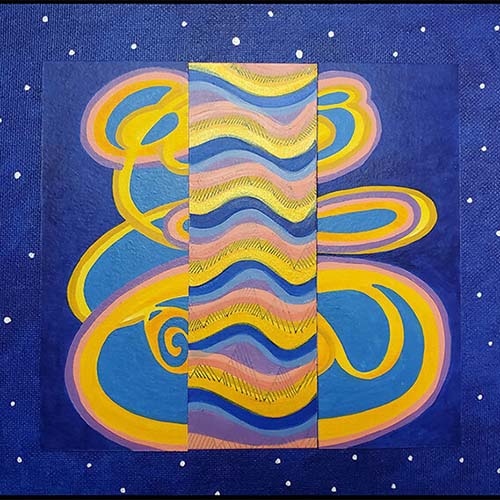SANTA FE, N.M. — For the last six years, the Institute of American Indian Arts has selected established Indigenous artists to participate in its Artist in Residency program.

The residencies allow the artists to experiment with new materials and techniques; share their practice with students and the community; and connect, network and share ideas with faculty and world-famous artists on a campus crackling with energy and culture.
Last year, when the campus closed in spring because of the COVID-19 pandemic, the residency program was left in the lurch. Residents were already chosen for the season, and they were preparing to make their way to Santa Fe.
“Our priority was to continue supporting artists in spite of COVID, so we had to figure out a way to still give our artists money and still have our students interact with the artists,” said Dr. Lara Evans, director of the Artist In Residence program. The residency “is a lifeline, not just in terms of the economics, but in terms of human connections. We did virtual residencies in the spring semester after we shut down our campus, and we’re continuing to do them. We are hoping to be able to have some in-person residencies for the second half of the fall semester.”
The Institute is now accepting applications for the next three-year cycle of residencies. Approximately 15 artists per year will receive stipends of $1,500-$6,000 for residencies lasting from two weeks to two months.
Developing the virtual residencies required some thinking outside of the box, and adapting artist talks with classes, demonstrations, community events, and artist interactions for a virtual platform, Evans said.
“Since our students were online, we had faculty and artists set up plans for the artists to do tours of their studio, artist talks that they would deliver via Zoom, and the artists would create new work and share documentation of that new work with us,” Evans said. “In some cases, artists were able to figure out ways of doing hands-on workshops with our students where we emailed kits to the students so they would have the right materials and tools, and we would all get together on Zoom for demonstrations, practice and help.”
Evans said residency money was repurposed to fit the virtual format. Ensuring virtual residents had the online resources and access they needed, and a proper space to create, were the main priorities. She added that the residents also were given ring lights, tripods and microphones to make the most of their virtual presentations.
“We sent the artists equipment and helped pay additional money so they could get internet or better internet,” Evans said. “We provided some funding for artists to rent studio space during the residency. We just repurposed funding that would have been spent on their travel. That really helped artists get through a tough time and transition and keep making during the pandemic.”
The virtual residents managed to make meaningful and timely work during their virtual residencies.
Hopi and Choctaw virtual resident Linda Lomahaftewa, who lives in Santa Fe and normally works at her paintings on her dining room table at home, accessed a studio where she created work, including the abstract collage painting “Healing Prayers for a Pandemic,” which will be featured in The Moving Land: 60+ Years of art by Linda Lomahaftewa, opening on Thursday, Jan. 28 at IAIA Museum of Contemporary Native Art.
“I ended up just keeping the studio space. So I’m paying for it now,” Lomahaftewa said. “It’s given me the opportunity to go in this space to work and be able to just leave the work there and then walk away and then come back to it.”
The virtual residency was vital for the artist, who said she hadn’t done any serious artwork for almost three years before the opportunity, because she was mourning her mother.
Lomahaftewa added that one of her favorite moments from the residency was doing a virtual talk with Santa Fe’s Wheelwright Museum of the American Indian, where she was initially slated to appear in person.
For Oglala Sioux artist Kevin Pourier, who was the first virtual resident, said the experience was a little bit of a let down.
“I was going to be working in the foundry. We had a beautiful house that was rented for us and my friends (in Santa Fe) were excited, and we were going to collaborate,” said Pourier, who specializes in carving buffalo horns into jewelry, and lives on the Pine Ridge Reservation in South Dakota. “There wasn’t the chance for me to hang out with these world-renowned artists. There’s nothing more energizing and thought provoking than hanging out and talking to these artists about what we’re doing and what we’re saying with our art.”
Pourier said the best thing to come out of his virtual residency was being able to make meaningful connections with faculty who encouraged him to visit the campus, share his knowledge, collaborate and take part in events as soon as it’s safe.
Despite the disappointment, Pourier said he recognizes that pivoting programs online in the age of COVID-19 is a big experiment and institutions are doing their best. He said he appreciates the effort.
“I think it’s awesome these institutions are attempting to do something” to assist artists during the pandemic, he said. “I was honored to be chosen.”
